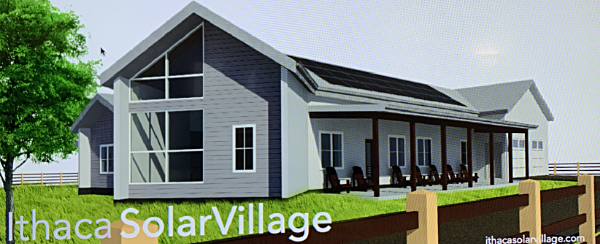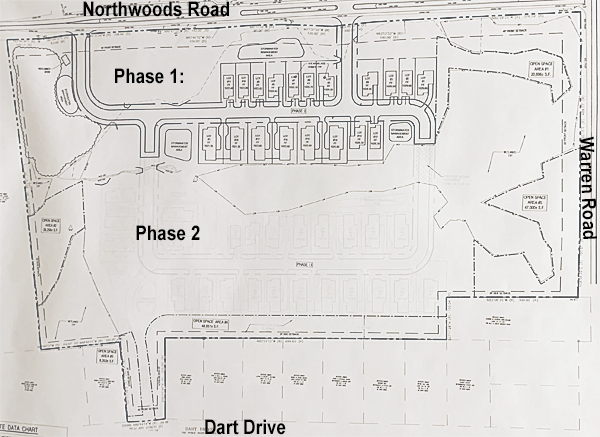- By Dan Veaner
- News
 Print
Print 
Solar Home Factory President and CEO Ryan Wallace Was back in the Village of Lansing to discuss issues with the village planning Board Monday for the 43-home Ithaca Solar Village project. The development is to be built between Northwood and Dart Drives, and bordered to the east and west by Warren Road and Marian Hartill Park. Wallace said that energy costs for the homes will be "completely net zero".
The Board asked questions and discussed preserving old trees, the design of the proposed private road, emergency vehicle access, and walking and bike pathways and walkability via Dart Drive to the shopping area of the Village.
If the project is approved it will create 20 new jobs at his Geneva factory. The homes are partially factory built, and the rest is built on site. The factory portion is a module that included the kitchen, bathrooms, and a laundry room, plus electrical, plumbing, heat pumps for heating and cooling, and a solar array. Bedrooms, living room, and great rooms are built on site, disguising the factory module to make the homes appear entirely site built.
The biggest change to the project since Wallace's November board visit is that instead of duplexes the homes will all be detached. 19 of the houses are planned for phase one. Planning Board member Tony Ingraffea asked whether the company pays extra when building net zero homes because the shared wall in a duplex is now going to be two separate exterior walls.
"We pay a financial price and the siding windows, the padded insulated envelope, and we pay a significant price in the cost of that envelope because we build our wall systems with a structural insulated panel, which is significantly more expensive than a sound-proof double two-by-four wall," Wallace explained. "The problem is there's an existing deed restriction on the property that only allows detached, single-family homes."
While there is a housing shortage in Tompkins County, Planning Board chair Lisa Schleelein said she is concerned about the market for single family homes. Wallace said that there is not a push by larger developers to create such developments, which he said may be an opportunity for companies like his.
"I do think that there is an opportunity for responsible, local, smaller development companies to play a role in the housing crisis," Wallace said. "And it is a major issue for us, the administrative hurdles to development. Not that we want relief from them or are seeking exemption. But it's a challenge."

The Board also discussed the value of a development being an open part of the Village rather than a gated community. Wallace said he embraces the idea of an open neighborhood that connects to the various facets of the Village.
"We want to have the connectivity and if someone wants their half acre lot and a gated community this isn't for them," he said. "This is someone who actually wants to have a closer interaction with their neighbors, who wants to have interaction with the surrounding village. We're excited to see where development in that area will go once this is in because we think that we can continue to add a bit to the critical mass of residents there. I know there's the bike trail. I like to see better connectivity to the shopping. So that's one of the questions that our buyers always ask us: 'Could I walk to the grocery store?'"
Ingraffea said that despite the fact that some trees would have to be removed to build the houses, he endorses the project because it is environmentally friendly.
"You've heard me preach before about every tree that's taken out should be replaced at some place and we don't know how to do that yet," he said. "But let's compare and contrast this proposed development with the kind where they kill all the trees. From a greenhouse gas point of view you can subtract greenhouse gases out of the atmosphere or you can add them to the atmosphere. That kind of development doesn't subtract. It only adds. Here you're subtracting but you're not adding. Okay, you killed some trees, so you're reducing the amount that you could subtract because the trees are sequestration units, but you're not adding anything because it's solar. You're not burning any fossil fuels to electrify or to heat these buildings. So there's a distinct advantage from a climate change point of view."
Wallace says he hopes to begin construction on infrastructure in July, with construction on the first batch of homes beginning later in the year.
"We won't commence phase one until we have 10 contracts so it's not speculative," Wallace said. "The time frame we hoped for time frame would be to commence in July with phase one be complete with the civil improvements -- the clearing, utilities and so on by October. Then we would be operating the home construction, you know, through the winter. And then the following year. If sales are brisk we'll just proceed with the entire site development. A medium case scenario would be phase two starting, probably, the following spring."
Code Enforcement/Zoning Officer Mike Scott said the next step will be for Wallace to present a preliminary plat to the board.
v16i5



